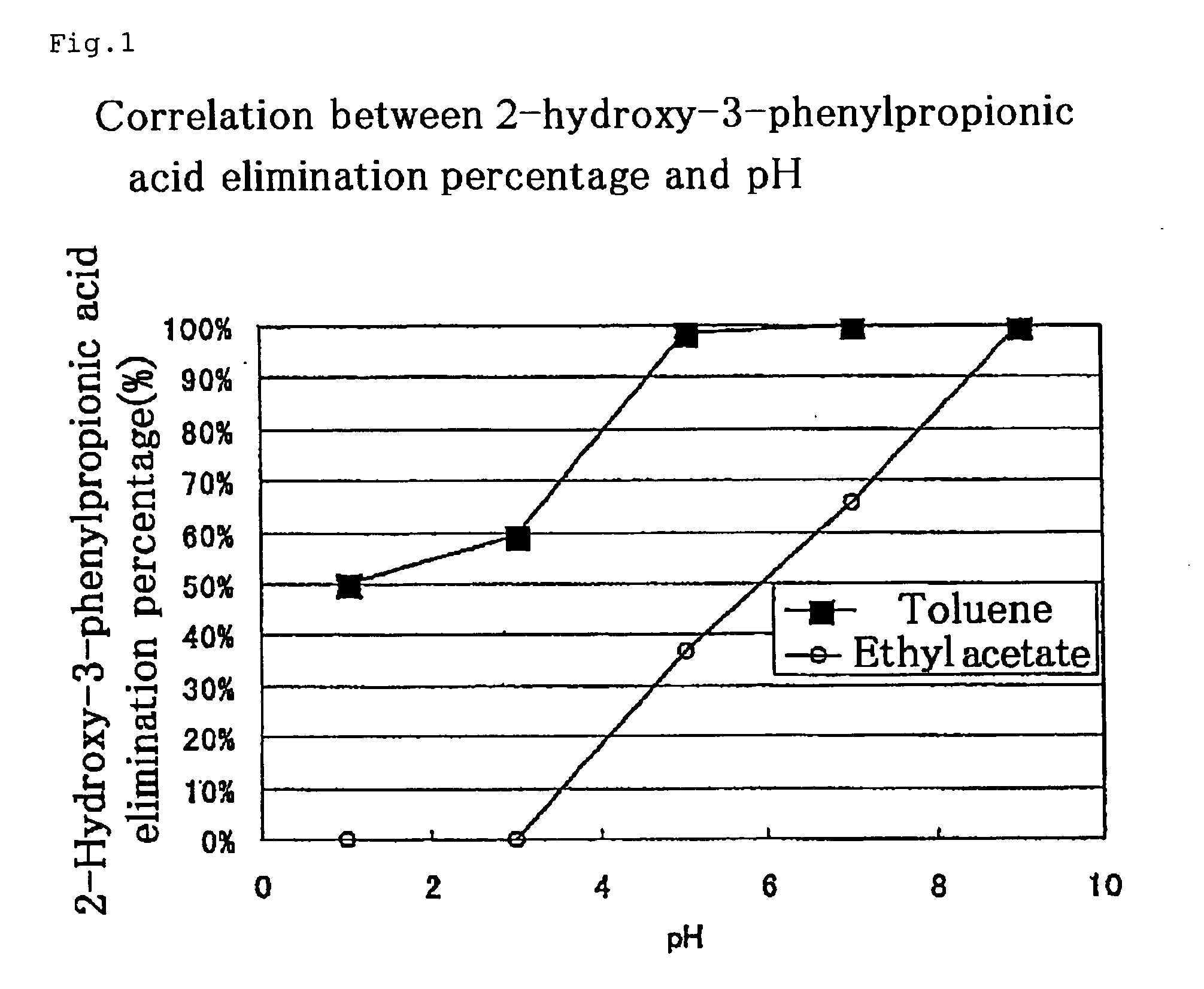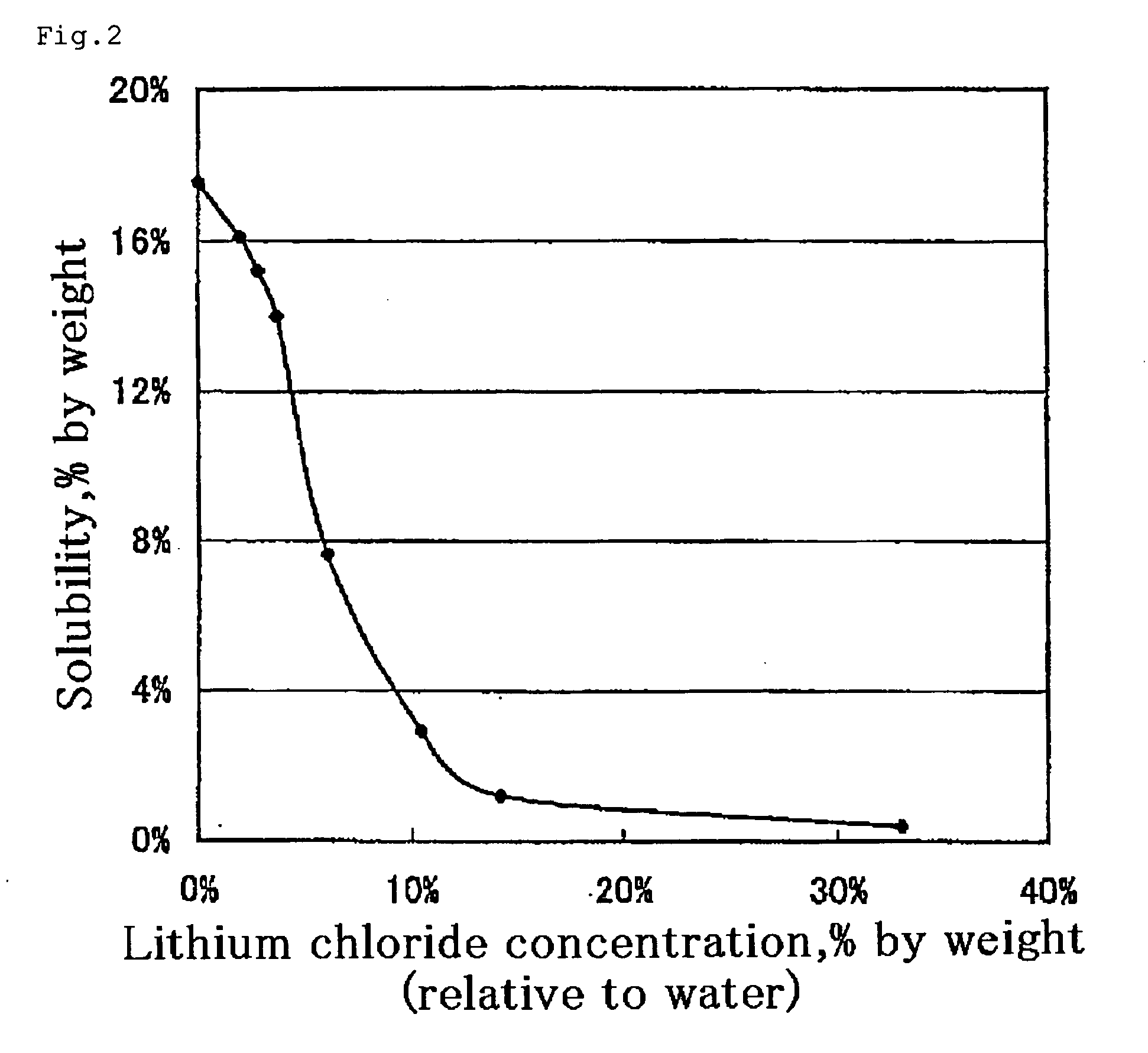Process for producing optically active 2-substituted carboxylic acid
a carboxylic acid and 2-substituted technology, applied in the preparation of sulfonic acid esters, carboxylic compound preparations, bulk chemical production, etc., can solve the problems of difficult to isolate and purify certain optically active 2-sulfonyloxycarboxylic acid esters, prone to racemization, and a considerable degree of racemization of some amino acids
- Summary
- Abstract
- Description
- Claims
- Application Information
AI Technical Summary
Benefits of technology
Problems solved by technology
Method used
Image
Examples
reference example 1
(S)-2-Hydroxy-3-phenylpropionic acid
[0183] L-Phenylalanine (400 g) was added to a solution prepared by diluting 237 g of concentrated sulfuric acid with 4400 g of water and, then, a mixture of 418 g of sodium nitrite and 800 g of water was added over 5 hours at an inside temperature of 20° C. After the addition, the mixture was continuously stirred at 20° C. for 20 hours. Thereafter, 4000 ml of tert-butyl methyl ether was added and, after 30 minutes of stirring at 20° C., the organic layer was separated (extract 1). Further, 2000 ml of tert-butyl methyl ether was added to the aqueous layer and, after 30 minutes of stirring at 20° C., the organic layer was separated (extract 2). The extract 1 and extract 2 were combined. The whole extract (4644 g) contained 348.7 g of (S)-2-hydroxy-3-phenylpropionic acid. This extract was concentrated under reduced pressure to give 1392 g of a concentrate. Hexane (4200 ml) was added gradually to this concentrate with stirring at 40° C. for causing c...
reference example 2
(R)-2-Bromo-3-phenylpropionic acid
[0184] D-Phenylalanine (100 g) was added to a solution prepared by diluting 150 g of sulfuric acid with 1100 g of water and, then, 360 g of potassium bromide was added at an inside temperature of 20° C. The mixture was cooled to an inside temperature of −10° C. and, in succession, a mixed solution composed of 64 g of sodium nitrite and 120 g of water was added over 2 hours. After completion of the addition, the mixture was stirred at −10° C. for 3.5 hours and 1000 ml of toluene was then added, and the mixture was stirred at 20° C. for 30 minutes. Thereafter, the organic layer was separated (extract 1). Further, 100 ml of toluene was added to the aqueous layer and, after 30 minutes of stirring at 20° C., the organic layer was separated (extract 2). The extracts 1 and 2 were combined. The whole extract (1086 g) contained 112 g of (R)-2-bromo-3-phenylpropionic acid. This extract was washed with six 200-ml portions of water to give 1063 g of an organic...
reference example 3
(R)-2-Bromo-3-phenylpropionic acid
[0185] D-Phenylalanine (500 g) was added to a solution prepared by diluting 2040 g of 47% hydrobromic acid with 750 g of water at an inside temperature of 0° C., the mixture was cooled to an inside temperature of −5° C. and, in succession, a mixed solution composed of 272 g of sodium nitrite and 510 g of water over 5 hours. After completion of the addition, the mixture was stirred at an inside temperature of −5° C. for 3 hours and then, after raising the temperature to 20° C., the mixture was stirred for 1 hour. Toluene (1600 ml) was added to this reaction mixture and, after 30 minutes of stirring at 20° C., the organic layer was separated (extract 1). Further, 800 ml of toluene was added to the aqueous layer and, after 30 minutes of stirring at 20° C., the organic layer was separated (extract 2). The extracts 1 and 2 were combined, and the whole extract was washed with four 500-ml portions of water (extract 3). The extract 3 obtained was concentra...
PUM
| Property | Measurement | Unit |
|---|---|---|
| pH | aaaaa | aaaaa |
| temperature | aaaaa | aaaaa |
| optical purity | aaaaa | aaaaa |
Abstract
Description
Claims
Application Information
 Login to View More
Login to View More - R&D
- Intellectual Property
- Life Sciences
- Materials
- Tech Scout
- Unparalleled Data Quality
- Higher Quality Content
- 60% Fewer Hallucinations
Browse by: Latest US Patents, China's latest patents, Technical Efficacy Thesaurus, Application Domain, Technology Topic, Popular Technical Reports.
© 2025 PatSnap. All rights reserved.Legal|Privacy policy|Modern Slavery Act Transparency Statement|Sitemap|About US| Contact US: help@patsnap.com



